Abstract
Previously, we detected a subset of gamma delta T cells in the newborn mouse thymus that responded to the mycobacterial heat shock protein Hsp60, as well as with what seemed to be a self-antigen. All of these cells expressed V gamma 1, most often in association with V delta 6+. It was not clear, however, whether similar, mature gamma delta cells with Hsp60 reactivity are common outside of the thymus, or rather, whether they are largely eliminated during development. From the data presented here, we estimate that gamma delta cells responding to Hsp60 comprise 10-20% of normal splenic and lymph node gamma delta T cells. Such cells, derived from adult spleen, always express a V gamma 1-J gamma 4-C gamma 4 gamma chain, although not all cells with this gamma chain show Hsp60 reactivity. Many of these V gamma 1+ cells also express V delta 6-J delta 1-C delta, though fewer than in V gamma 1+ cells from the newborn thymus. Extensive diversity is evident in both the gamma and delta chain junctional amino acids of the receptors of these cells, indicating that they may largely develop in the thymus of older animals or undergo peripheral expansion. Finally, we found that all such cells responding to both a putative self-antigen and to mycobacterial Hsp60 respond to a 17-amino acid synthetic peptide representing amino acids 180-196 of the Mycobacterium leprae Hsp60 sequence. This report demonstrates that a large subset of Hsp60-reactive peripheral lymphoid gamma delta T cells preexists in normal adult mice, all members of which respond to a single segment of this common heat shock protein.
Full text
PDF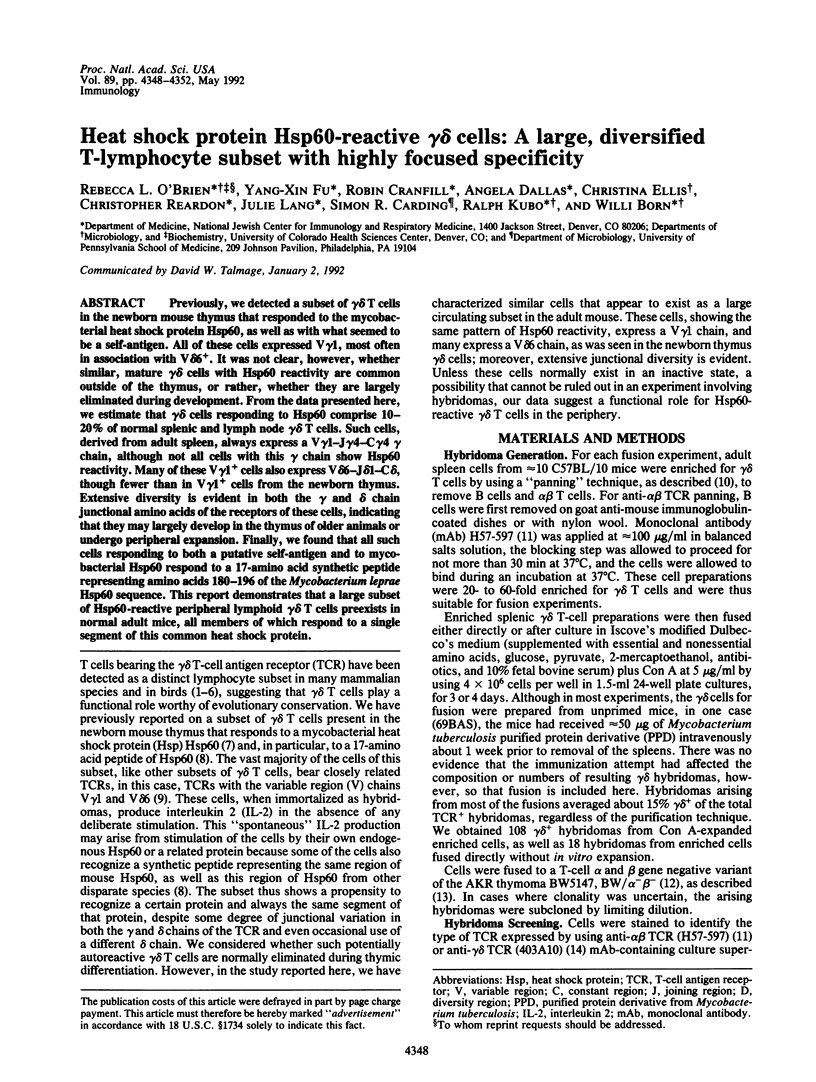
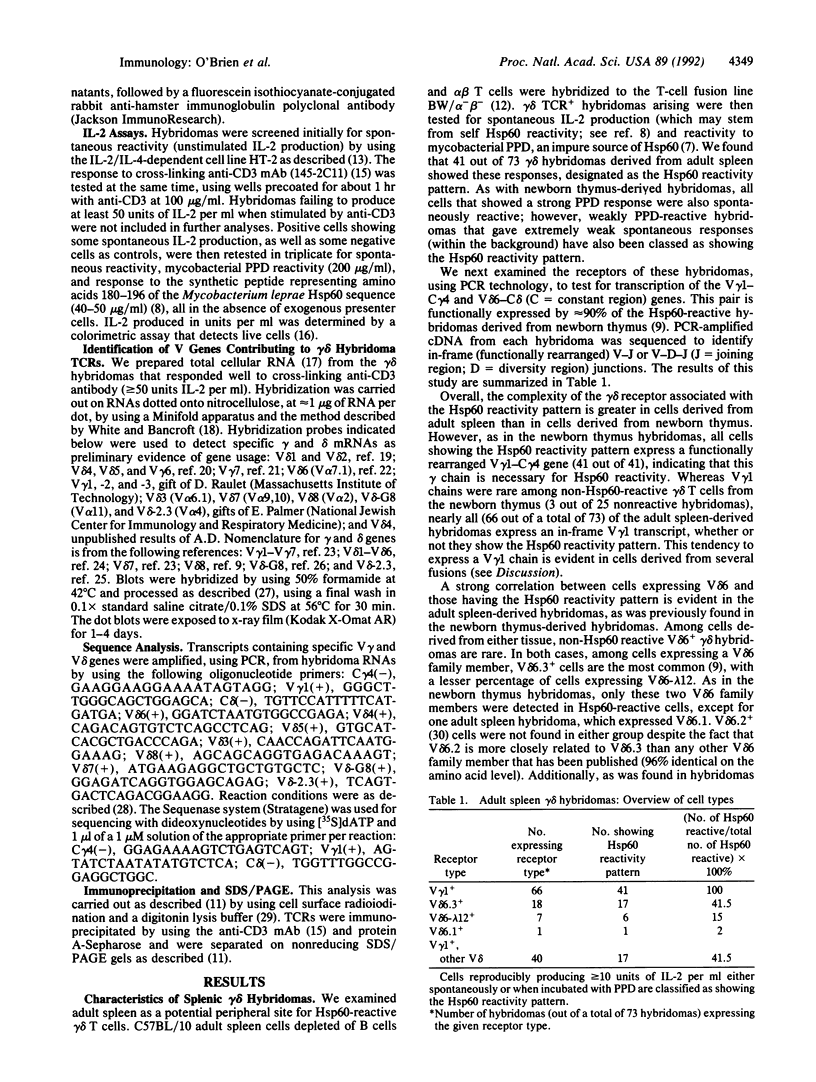
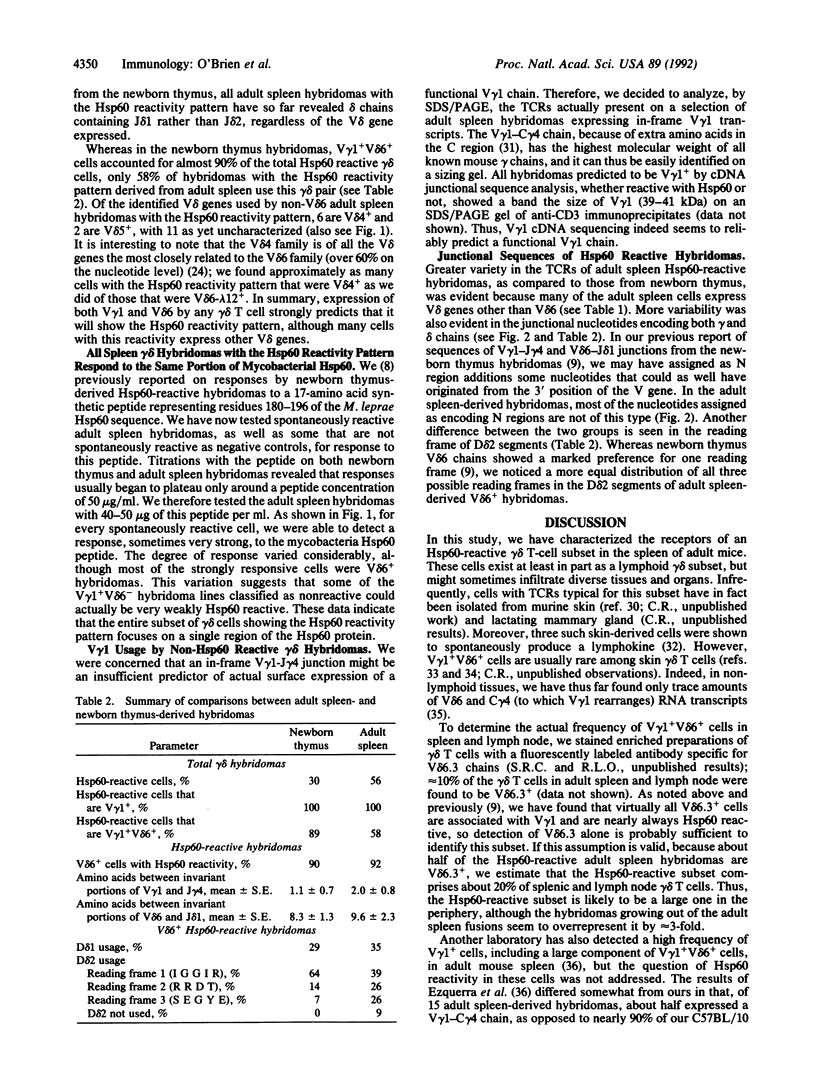
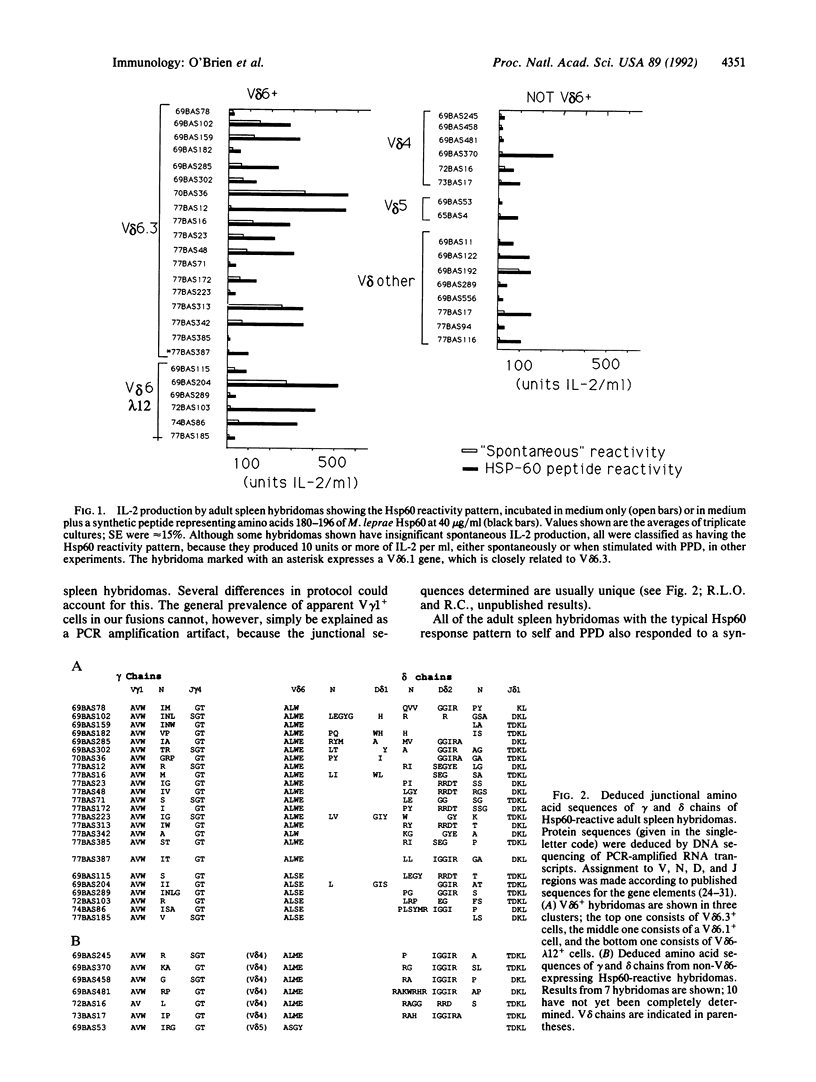
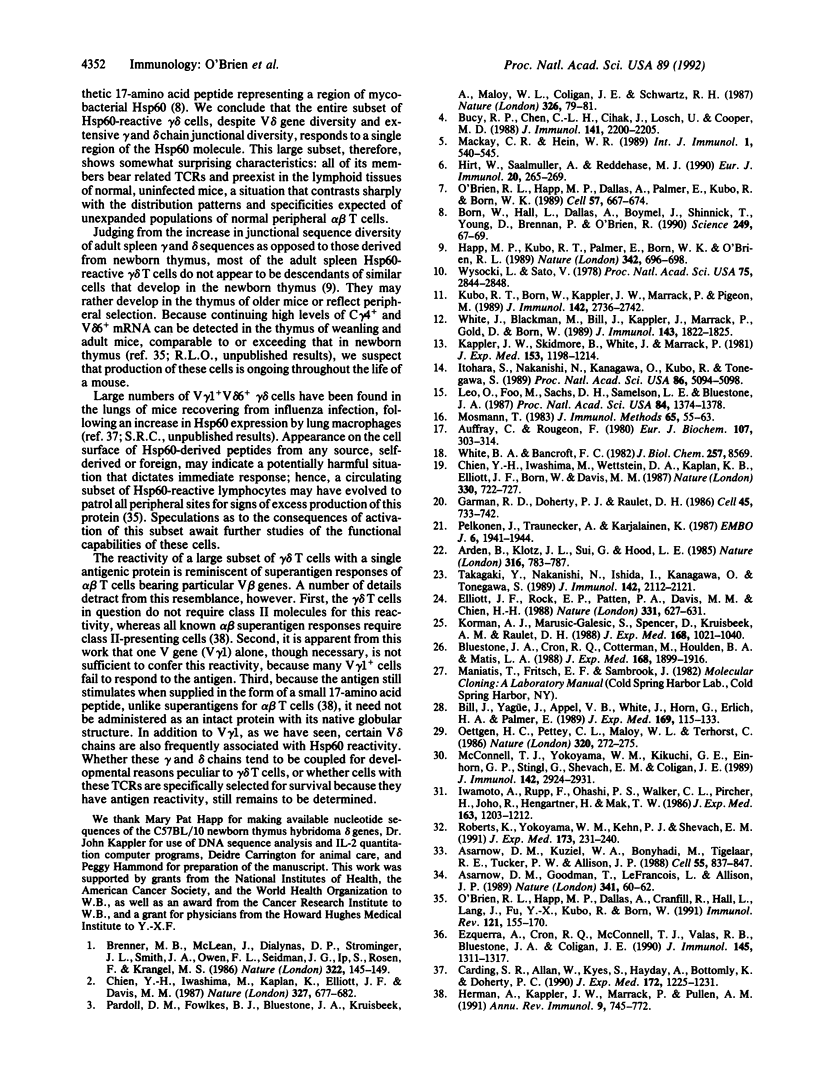
Selected References
These references are in PubMed. This may not be the complete list of references from this article.
- Arden B., Klotz J. L., Siu G., Hood L. E. Diversity and structure of genes of the alpha family of mouse T-cell antigen receptor. 1985 Aug 29-Sep 4Nature. 316(6031):783–787. doi: 10.1038/316783a0. [DOI] [PubMed] [Google Scholar]
- Asarnow D. M., Goodman T., LeFrancois L., Allison J. P. Distinct antigen receptor repertoires of two classes of murine epithelium-associated T cells. Nature. 1989 Sep 7;341(6237):60–62. doi: 10.1038/341060a0. [DOI] [PubMed] [Google Scholar]
- Asarnow D. M., Kuziel W. A., Bonyhadi M., Tigelaar R. E., Tucker P. W., Allison J. P. Limited diversity of gamma delta antigen receptor genes of Thy-1+ dendritic epidermal cells. Cell. 1988 Dec 2;55(5):837–847. doi: 10.1016/0092-8674(88)90139-0. [DOI] [PubMed] [Google Scholar]
- Auffray C., Rougeon F. Purification of mouse immunoglobulin heavy-chain messenger RNAs from total myeloma tumor RNA. Eur J Biochem. 1980 Jun;107(2):303–314. doi: 10.1111/j.1432-1033.1980.tb06030.x. [DOI] [PubMed] [Google Scholar]
- Bill J., Yagüe J., Appel V. B., White J., Horn G., Erlich H. A., Palmer E. Molecular genetic analysis of 178 I-Abm12-reactive T cells. J Exp Med. 1989 Jan 1;169(1):115–133. doi: 10.1084/jem.169.1.115. [DOI] [PMC free article] [PubMed] [Google Scholar]
- Bluestone J. A., Cron R. Q., Cotterman M., Houlden B. A., Matis L. A. Structure and specificity of T cell receptor gamma/delta on major histocompatibility complex antigen-specific CD3+, CD4-, CD8- T lymphocytes. J Exp Med. 1988 Nov 1;168(5):1899–1916. doi: 10.1084/jem.168.5.1899. [DOI] [PMC free article] [PubMed] [Google Scholar]
- Born W., Hall L., Dallas A., Boymel J., Shinnick T., Young D., Brennan P., O'Brien R. Recognition of a peptide antigen by heat shock--reactive gamma delta T lymphocytes. Science. 1990 Jul 6;249(4964):67–69. doi: 10.1126/science.1695022. [DOI] [PubMed] [Google Scholar]
- Brenner M. B., McLean J., Dialynas D. P., Strominger J. L., Smith J. A., Owen F. L., Seidman J. G., Ip S., Rosen F., Krangel M. S. Identification of a putative second T-cell receptor. Nature. 1986 Jul 10;322(6075):145–149. doi: 10.1038/322145a0. [DOI] [PubMed] [Google Scholar]
- Bucy R. P., Chen C. L., Cihak J., Lösch U., Cooper M. D. Avian T cells expressing gamma delta receptors localize in the splenic sinusoids and the intestinal epithelium. J Immunol. 1988 Oct 1;141(7):2200–2205. [PubMed] [Google Scholar]
- Carding S. R., Allan W., Kyes S., Hayday A., Bottomly K., Doherty P. C. Late dominance of the inflammatory process in murine influenza by gamma/delta + T cells. J Exp Med. 1990 Oct 1;172(4):1225–1231. doi: 10.1084/jem.172.4.1225. [DOI] [PMC free article] [PubMed] [Google Scholar]
- Chien Y. H., Iwashima M., Kaplan K. B., Elliott J. F., Davis M. M. A new T-cell receptor gene located within the alpha locus and expressed early in T-cell differentiation. 1987 Jun 25-Jul 1Nature. 327(6124):677–682. doi: 10.1038/327677a0. [DOI] [PubMed] [Google Scholar]
- Chien Y. H., Iwashima M., Wettstein D. A., Kaplan K. B., Elliott J. F., Born W., Davis M. M. T-cell receptor delta gene rearrangements in early thymocytes. Nature. 1987 Dec 24;330(6150):722–727. doi: 10.1038/330722a0. [DOI] [PubMed] [Google Scholar]
- Elliott J. F., Rock E. P., Patten P. A., Davis M. M., Chien Y. H. The adult T-cell receptor delta-chain is diverse and distinct from that of fetal thymocytes. Nature. 1988 Feb 18;331(6157):627–631. doi: 10.1038/331627a0. [DOI] [PubMed] [Google Scholar]
- Ezquerra A., Cron R. Q., McConnell T. J., Valas R. B., Bluestone J. A., Coligan J. E. T cell receptor delta-gene expression and diversity in the mouse spleen. J Immunol. 1990 Sep 1;145(5):1311–1317. [PubMed] [Google Scholar]
- Garman R. D., Doherty P. J., Raulet D. H. Diversity, rearrangement, and expression of murine T cell gamma genes. Cell. 1986 Jun 6;45(5):733–742. doi: 10.1016/0092-8674(86)90787-7. [DOI] [PubMed] [Google Scholar]
- Happ M. P., Kubo R. T., Palmer E., Born W. K., O'Brien R. L. Limited receptor repertoire in a mycobacteria-reactive subset of gamma delta T lymphocytes. Nature. 1989 Dec 7;342(6250):696–698. doi: 10.1038/342696a0. [DOI] [PubMed] [Google Scholar]
- Herman A., Kappler J. W., Marrack P., Pullen A. M. Superantigens: mechanism of T-cell stimulation and role in immune responses. Annu Rev Immunol. 1991;9:745–772. doi: 10.1146/annurev.iy.09.040191.003525. [DOI] [PubMed] [Google Scholar]
- Hirt W., Saalmüller A., Reddehase M. J. Distinct gamma/delta T cell receptors define two subsets of circulating porcine CD2-CD4-CD8- T lymphocytes. Eur J Immunol. 1990 Feb;20(2):265–269. doi: 10.1002/eji.1830200206. [DOI] [PubMed] [Google Scholar]
- Itohara S., Nakanishi N., Kanagawa O., Kubo R., Tonegawa S. Monoclonal antibodies specific to native murine T-cell receptor gamma delta: analysis of gamma delta T cells during thymic ontogeny and in peripheral lymphoid organs. Proc Natl Acad Sci U S A. 1989 Jul;86(13):5094–5098. doi: 10.1073/pnas.86.13.5094. [DOI] [PMC free article] [PubMed] [Google Scholar]
- Iwamoto A., Rupp F., Ohashi P. S., Walker C. L., Pircher H., Joho R., Hengartner H., Mak T. W. T cell-specific gamma genes in C57BL/10 mice. Sequence and expression of new constant and variable region genes. J Exp Med. 1986 May 1;163(5):1203–1212. doi: 10.1084/jem.163.5.1203. [DOI] [PMC free article] [PubMed] [Google Scholar]
- Kappler J. W., Skidmore B., White J., Marrack P. Antigen-inducible, H-2-restricted, interleukin-2-producing T cell hybridomas. Lack of independent antigen and H-2 recognition. J Exp Med. 1981 May 1;153(5):1198–1214. doi: 10.1084/jem.153.5.1198. [DOI] [PMC free article] [PubMed] [Google Scholar]
- Korman A. J., Marusic-Galesic S., Spencer D., Kruisbeek A. M., Raulet D. H. Predominant variable region gene usage by gamma/delta T cell receptor-bearing cells in the adult thymus. J Exp Med. 1988 Sep 1;168(3):1021–1040. doi: 10.1084/jem.168.3.1021. [DOI] [PMC free article] [PubMed] [Google Scholar]
- Kubo R. T., Born W., Kappler J. W., Marrack P., Pigeon M. Characterization of a monoclonal antibody which detects all murine alpha beta T cell receptors. J Immunol. 1989 Apr 15;142(8):2736–2742. [PubMed] [Google Scholar]
- Leo O., Foo M., Sachs D. H., Samelson L. E., Bluestone J. A. Identification of a monoclonal antibody specific for a murine T3 polypeptide. Proc Natl Acad Sci U S A. 1987 Mar;84(5):1374–1378. doi: 10.1073/pnas.84.5.1374. [DOI] [PMC free article] [PubMed] [Google Scholar]
- Mackay C. R., Hein W. R. A large proportion of bovine T cells express the gamma delta T cell receptor and show a distinct tissue distribution and surface phenotype. Int Immunol. 1989;1(5):540–545. doi: 10.1093/intimm/1.5.540. [DOI] [PubMed] [Google Scholar]
- McConnell T. J., Yokoyama W. M., Kikuchi G. E., Einhorn G. P., Stingl G., Shevach E. M., Coligan J. E. Delta-chains of dendritic epidermal T cell receptors are diverse but pair with gamma-chains in a restricted manner. J Immunol. 1989 Apr 15;142(8):2924–2931. [PubMed] [Google Scholar]
- Mosmann T. Rapid colorimetric assay for cellular growth and survival: application to proliferation and cytotoxicity assays. J Immunol Methods. 1983 Dec 16;65(1-2):55–63. doi: 10.1016/0022-1759(83)90303-4. [DOI] [PubMed] [Google Scholar]
- O'Brien R. L., Happ M. P., Dallas A., Cranfill R., Hall L., Lang J., Fu Y. X., Kubo R., Born W. Recognition of a single hsp-60 epitope by an entire subset of gamma delta T lymphocytes. Immunol Rev. 1991 Jun;121:155–170. doi: 10.1111/j.1600-065x.1991.tb00827.x. [DOI] [PubMed] [Google Scholar]
- O'Brien R. L., Happ M. P., Dallas A., Palmer E., Kubo R., Born W. K. Stimulation of a major subset of lymphocytes expressing T cell receptor gamma delta by an antigen derived from Mycobacterium tuberculosis. Cell. 1989 May 19;57(4):667–674. doi: 10.1016/0092-8674(89)90135-9. [DOI] [PubMed] [Google Scholar]
- Oettgen H. C., Pettey C. L., Maloy W. L., Terhorst C. A T3-like protein complex associated with the antigen receptor on murine T cells. Nature. 1986 Mar 20;320(6059):272–275. doi: 10.1038/320272a0. [DOI] [PubMed] [Google Scholar]
- Pardoll D. M., Fowlkes B. J., Bluestone J. A., Kruisbeek A., Maloy W. L., Coligan J. E., Schwartz R. H. Differential expression of two distinct T-cell receptors during thymocyte development. Nature. 1987 Mar 5;326(6108):79–81. doi: 10.1038/326079a0. [DOI] [PubMed] [Google Scholar]
- Pelkonen J., Traunecker A., Karjalainen K. A new mouse TCR V gamma gene that shows remarkable evolutionary conservation. EMBO J. 1987 Jul;6(7):1941–1944. doi: 10.1002/j.1460-2075.1987.tb02455.x. [DOI] [PMC free article] [PubMed] [Google Scholar]
- Roberts K., Yokoyama W. M., Kehn P. J., Shevach E. M. The vitronectin receptor serves as an accessory molecule for the activation of a subset of gamma/delta T cells. J Exp Med. 1991 Jan 1;173(1):231–240. doi: 10.1084/jem.173.1.231. [DOI] [PMC free article] [PubMed] [Google Scholar]
- Takagaki Y., Nakanishi N., Ishida I., Kanagawa O., Tonegawa S. T cell receptor-gamma and -delta genes preferentially utilized by adult thymocytes for the surface expression. J Immunol. 1989 Mar 15;142(6):2112–2121. [PubMed] [Google Scholar]
- White B. A., Bancroft F. C. Cytoplasmic dot hybridization. Simple analysis of relative mRNA levels in multiple small cell or tissue samples. J Biol Chem. 1982 Aug 10;257(15):8569–8572. [PubMed] [Google Scholar]
- White J., Blackman M., Bill J., Kappler J., Marrack P., Gold D. P., Born W. Two better cell lines for making hybridomas expressing specific T cell receptors. J Immunol. 1989 Sep 15;143(6):1822–1825. [PubMed] [Google Scholar]
- Wysocki L. J., Sato V. L. "Panning" for lymphocytes: a method for cell selection. Proc Natl Acad Sci U S A. 1978 Jun;75(6):2844–2848. doi: 10.1073/pnas.75.6.2844. [DOI] [PMC free article] [PubMed] [Google Scholar]


